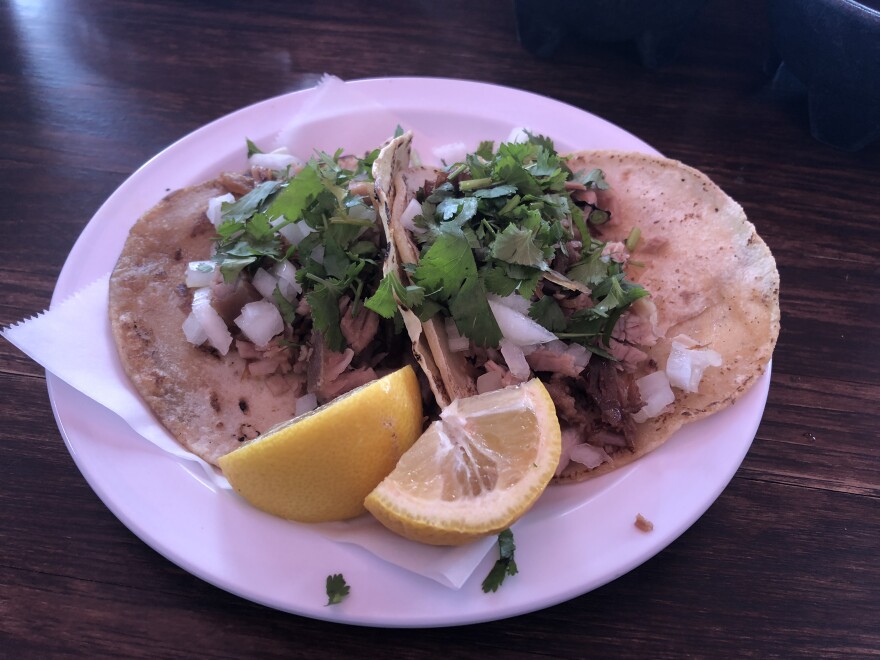A conference to help predict the future of LA's mobility, a cycling taco tour that runs through the heart of Boyle Heights, your SoCal weekend planner.
CA GOP Convention goals could be pretty 'modest'
Every week, Take Two breaks down the biggest stories in California politics in the weekly segment, State of Affairs. This week:
- Republicans assemble! The California GOP will converge on San Diego this weekend for their annual convention. On the docket: Oh, you know, just the future of the party. Political analyst Raphael Sonenshein says the future of the party in the state could hinge on whether or not the party endorses a gubernatorial candidate. New rules dictate that a candidate will need 60 percent support. If they can get it, however, Sonenshein says it would be a big deal:
If one candidate pulls ahead of the other, it's possible they could knock Antonio Villaraigosa out of the run-off in our bizarre top-two system. If they come out evenly matched, then I think that improves Villaraigosa's chance of edging them out to get into that spot.
Also:
- Pot politics? Big green is becoming an increasingly powerful force in California politics
- Legal marijuana is OK by Sen. Dianne Feinstein — now, anyway. What's behind the about-face?
Guests:
- Scott Shafer, co-host for KQED's Political Breakdown
- Raphael Sonenshein, executive director of the Pat Brown Institute at Cal State LA
Here's the future of LA traffic, according to the people planning to improve it
We all know traffic is bad in Los Angeles and getting worse. We also know that autonomous cars will be a reality in the not-too-distant future. But how do we get from where we are now, which is stuck, to where everyone says we're headed?
"The reality is you can't change a system right away in a large city," said Kian Gohar, executive director of the X Prize Foundation. "Just like any cruise liner or large company, you can't experiment while the ecosystem still has to function every single day and be fully available to the entire community."
Which is why the city is furiously planning and taking preliminary steps, many of which were laid out during Thursday's Future of the Automobile Conference at the Petersen Automotive Museum, presented in partnership with the Los Angeles World Affairs Council.
"The idea is that the department of transportation in the future is more of a mobility manager, so we're thinking about how to manage an ecosystem of services," said Ashley Hand, co-founder of a group called CityFi, and author of the transportation technology strategy for the city.
She says the city is working on three key ideas.
1. Mobility as a service
"The idea is a platform of all the service options that are available to you so you can really right size mobility in a single platform -- pay for it, reserve it. So the days you need to walk, the days you want to ride a bike, the days you need to lug the kids around with you to soccer games, you have those options through that single platform.
Right now, most of us who can afford it get around with our own personal cars, and the cars we're buying are usually big -- bought for the rare occasions we actually need all the space.
But what the city wants to do is help people choose the right tool for the job whether it's a train, bus, bike, electric scooter or car share. And then make the purchase of those different options seamless. A preliminary example of this is the city's GO LA app.
2. Data as a service
In other words, real-time data sharing so that connected and autonomous cars can communicate with infrastructure, like traffic lights. So if an area is particularly congested, the signal could react in real time and get the traffic to flow more easily. Another way that could manifest is with high-occupancy lanes on city streets, kind of like we already have on the freeway, only it would be with a bus in a priority lane on a street like Wilshire Blvd., which would get every green light.
3. Infrastructure as a service
The idea is that people will pay for infrastructure as they use it, much like the state's recent Road Charge pilot program, which investigated charging drivers by the mile instead of through a gas tax. It's "to flip the value proposition of how we pay for our infrastructure," Hand said.
To that end, the city plans to incentivize the behaviors it wants to see, like using public transit or carpooling or traveling at off hours, and disincentivize the things it wants to discourage, like taking every single trip in a car.
On the incentive side, it could be that drivers are rewarded for taking the carpool version of Lyft or Uber with something like a Starbucks gift card, which is being done with a pilot program in Miami.
Disincentives would be things like congestion pricing -- charging people when they travel in their personal cars at peak times, or charging Lyft and Uber for using the curb.
Underground tunnels
"When you think about dense metropolitan areas, it's pretty hard to acquire new right of way. That brings with it a lot of planning, a lot of potential relocation of existing businesses," said David DeRosa, a transportation planner with the Los Angeles company AECOM, which is working with the city of Los Angeles. "That constraint is alleviated when you go underground."
De Rosa said there are two main applications for underground tunnels — commuting, but also freight.
A lot of traffic is due to moving freight because we're so close to the ports. Moving freight to a tunnel undergound would help reduce traffic above ground and also improve air quality In addition to working with the city of L.A., De Rosa's company did a feasibility analysis with Virgin Hyperloop One in LA that was focused on the ports.
Air taxis and drones
De Rosa said building developers are beginning to factor air taxis into their designs, so — skeptical as a lot of people might be about flying ride hail services — this seems to indicate that a lot of people think it's going to be real. Drones also have the potential to help reduce traffic by taking delivery trucks off the road.
Traffic will still get worse
In L.A., there will be "more and more traffic. Always," Gohar said. "We know it's a problem for all of us, and there's got to be a lot of different players and community people involved to address this major problem. It's not just the city. It's not just car designers. It's really all hands on deck in creating these public and private partnerships to try to figure out what are some solutions to solving traffic in the city."
If you think traffic is bad now. It will only get worse. Right now, 50% of the world's population lives in cities, but by 2050, that will be 75%, Gohar said.
So imagine L.A. with 50% more people than it has now. To prevent everyone who moves here from getting around with a personally owned car, Los Angeles is actively working to provide options.
Even with sanctuary laws, feds can still find immigrants in jails and the community
Seeing L.A. tear itself apart made Michelle realize the city was home
NO PLACE LIKE L.A. IS OUR SERIES THAT ASKS L.A. TRANSPLANTS AND IMMIGRANTS: "WHEN WAS THE MOMENT YOU FELT THAT LOS ANGELES WAS TRULY HOME?"
THIS IS THE STORY OF Michelle Kemmer in Woodland Hills WHO'S ORIGINALLY FROM Minnesota.
I moved [here] in 1987 to go to school, but the primary reason was to escape winter and just kind of going along like you do when you're young – trying to figure out what you're doing with your life.
But then in 1992, the L.A. riots happened.
I had been at work. I knew there was something going on.
But I didn't really quite know. I was poor at the time, so I just had a teeny television that was barely black-and-white. It was mostly static, kind of trying to watch this to figure out what was going on.
I thought, you know, I'm going to drive up to Mulholland. There's a nice view of the city from up there and kind of see what's going on.
There was a whole crowd of people up there just watching the city burn.
And I just felt so sad. I get choked up now even talking about it so many years later.
I grew up in Minnesota, but I never felt like home.
Los Angeles didn't really feel like home until the L.A. riots.
That was kind of when I realized that this is my city, that I was actually a part of it, a part of something, a part of a community.
What are we doing to each other?
TELL US YOUR STORY, TOO. IF YOU'RE A TRANSPLANT OR IMMIGRANT, WHEN WAS THE MOMENT YOU THOUGHT TO YOURSELF, "L.A. FEELS LIKE HOME, NOW?"
This LA bike tour serves up Boyle Heights history — and tacos
How do you like your tacos?
Street style with onion, cilantro and salsa? Or maybe you're one of those people who like to pile it high with cheese and guac?
Well, how about this third option?

Multiple tacos in-between stops on a nine-mile bike ride through Boyle Heights? With a side of local history, of course. Sound like your jam? That's what Arturo Palacios offers on his L.A. Cycle Taco Tour.
"Initially, I had planned to do the route around Hollywood. But at the same time, we were thinking, we want to show people the real side of Los Angeles, not the manicured side," said Palacios when he took Take Two producers Lori Galarreta and Austin Cross for a short but flavorful tour.
So, they took the tour to the east side and kept it focused on Boyle Heights. Because of its rich history and traditions, Boyle Heights was the perfect setting for the cycling taco tour.
"Folks can learn about (the history) and the type of cuisine we're going to have on this tour from different regions of Mexico," Palacios explained.
For the special Take Two tour, we hit three spots over a shorter 4 1/2-mile route, and throughout the entire ride, Palacios talked about the city's rich and sometimes little-known history.
First stop, Zamora Brothers.

Serving the community for 48 years
Zamora Brothers is located on East Cesar Chavez Avenue, just south of the 10 and 101 freeway interchange. In the Boyle Heights community, its known for its carnitas, which is prepped in the style of Guanajuato cuisine.
"Doing my tours on bicycles, allows us to go through places that nobody else could go through," Palacios said.
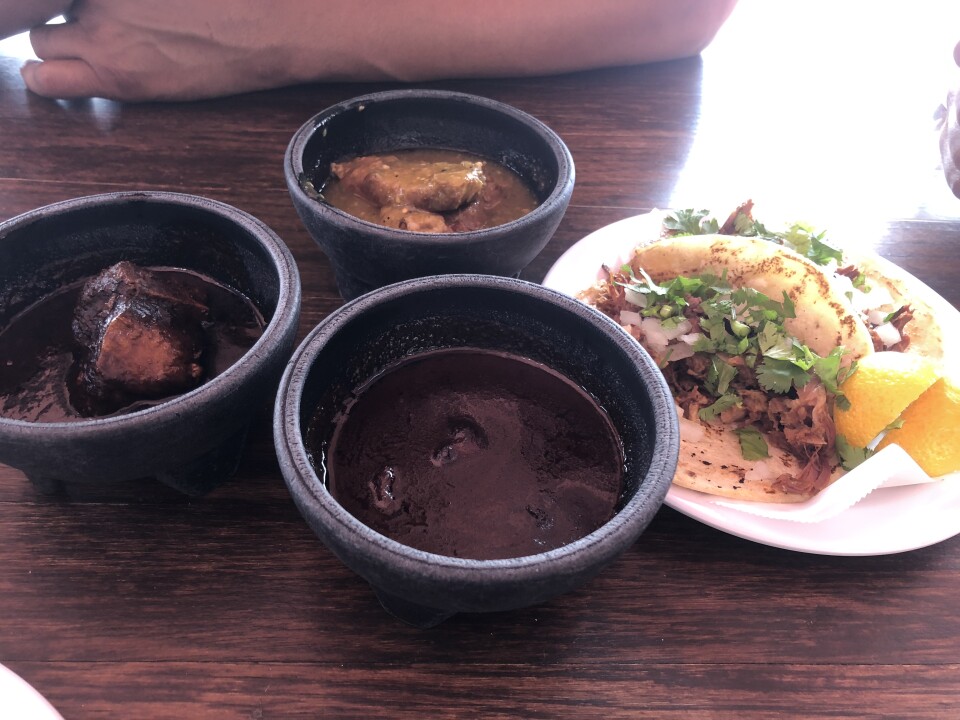
Rolling with the pushback
Pairing bicycles and tacos creates a sense of going off the beaten trail to discover hidden gems.
Though, rolling through these communities and patronizing these types of taco shops has not been without pushback.
"There are people out here who are against gentrification and they are known for heckling folks," Palacios said. "I think most of them are misinformed. I like to not heckle them back but kind of argue with them and ... point out the facts to what we're doing here."
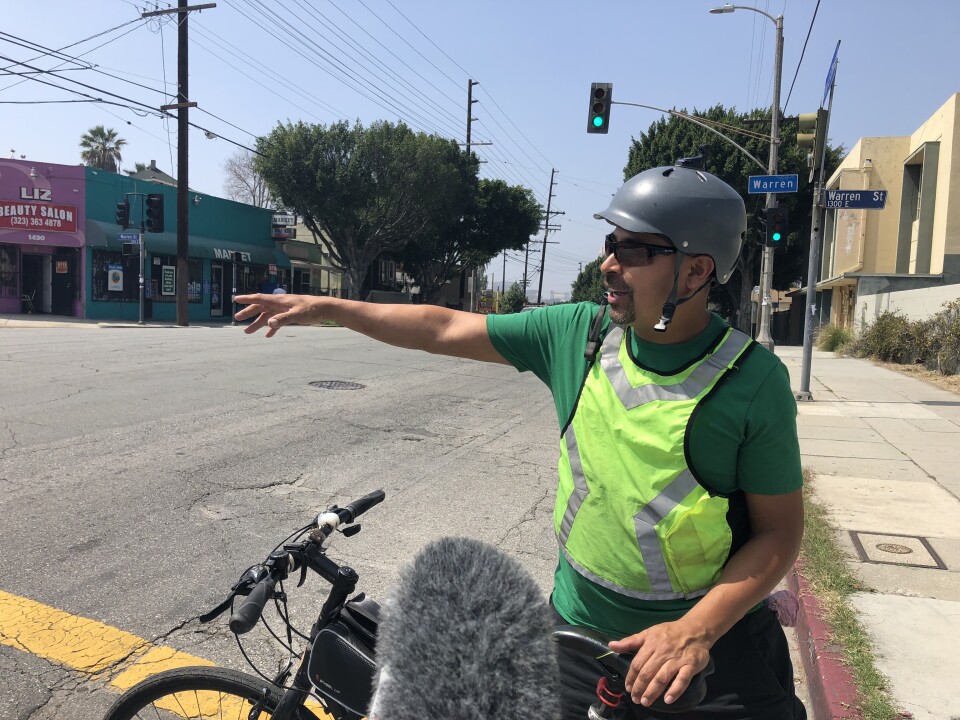
And what Palacios is trying to do is show another side of the city and communities he loves. Oftentimes he gets native-born Angelenos coming along on his tour, and many times they challenge him to teach them something they don't know about L.A.
"A lot of times, a lot Angelenos say...'I didn't know that about this community,' and that makes me feel good," said Palacios.
And when it comes to tourists and out of towners?
"They already have a perception of these areas," said Palacios, "So I like to change their perception."
Next stop, a taco truck called Monchies, which Palacios clarified, does not mean muchies, it's actually a nickname for people named Ramón.
The Monchies memela
The Monchies taco truck has been a stop on the taco tour since the beginning. Before, the tour would stop at the truck to buy tacos, but then Palacios kept noticing another very popular dish being served by the truck.
"Something that didn't even look like a taco and I had to try one for myself, and I was blown away," he said.
He was referring to the memela, or as he nicknamed it, "the pimped-out taco."

This particular memela was made in the Puebla style — Puebla being a state in Mexico where black beans are king — and as a result, this dish is jam-packed with them. Literally.
It kind of looks like a pizza, but it's got all kinds of goodies:
- Sits on a handmade tortilla
- Avocado
- Black beans
- House red sauce
- California chilis
- Queso fresco
Palacios said it's a crowd pleaser on the cycling tours and a favorite amongst vegetarians. (For obvious reasons.)
A spot filled with OG's
Nothing washes down tacos and memelas like some culture.
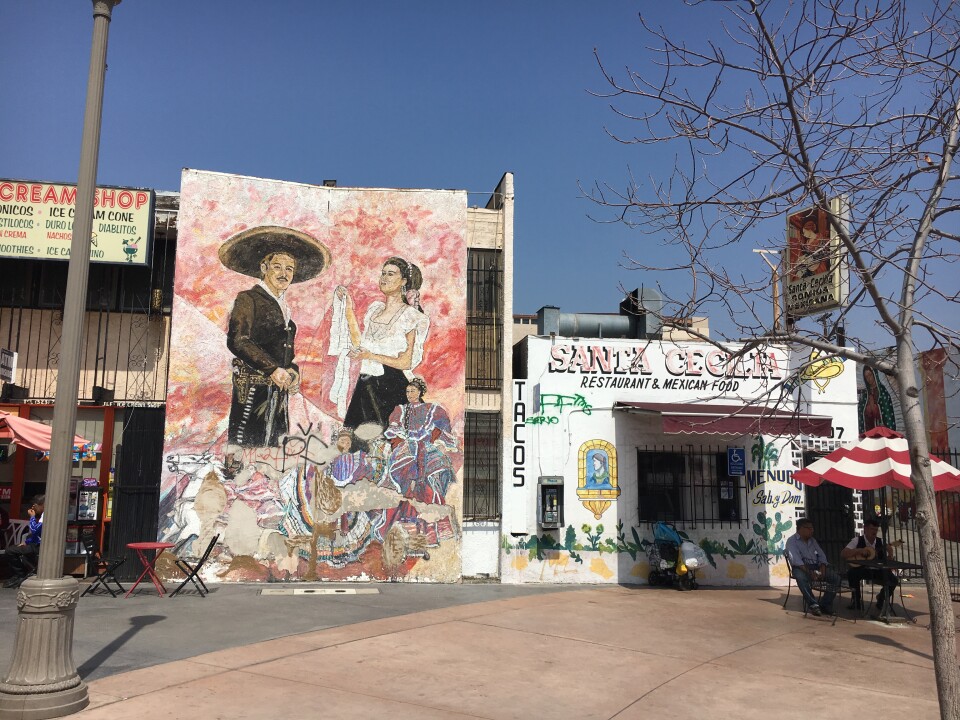
"Mariachi Plaza has been the hang out for mariachis in Boyle Heights for the last 60 years," said Palacios.
Mariachi Plaza offered the chance to talk about the culture of the mariachis, and Palacios jumped at the chance to feature it as a stop along the taco tour.
"The mariachis hanging out here, a lot of them have been hanging out here for years... the fellas you see standing about here tuning their instruments, these guys are the OG's here," Palacios.
These original mariachis are more so your father's musician, not so much cut out for today's musicscape that requires social media and self-promotion.
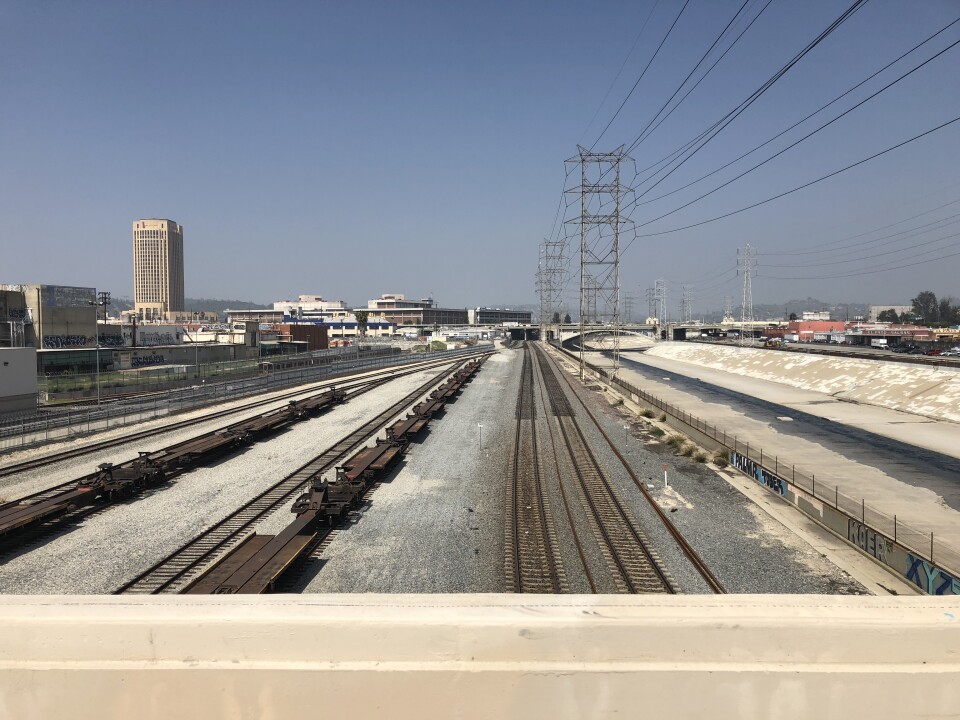
Biking through Los Angeles gives you a different view of the city. Things pass by slower, you see and notice more. It all feels more personal. And that's what it's all about for Palacios.
"On a bicycle, you slow down and you appreciate your community more," he said.
You can learn more about the L.A. Cycle Taco Tour here.
Disneyland goth gathering Bats Day scales back
For 20 years, Disneyland has been home to a quirky SoCal tradition: Bats Day.
That's the annual Goth gathering at the park, featuring a meet-up day in Disneyland and other offsite events like concerts, crafts markets and even a costume ball. This year's event takes place May 5 and 6.
The celebration isn't an official event sponsored by Disney. It's a labor of love for the organizers who have watched the Bats Day crowds grow each year.
"Bats Day has kind of become one of those staples now. We have probably about 8,000 to 10,000 people come to Disneyland for this Goth convention," said founder and executive producer Noah K.
The event started as a group of Goth friends getting together at Disneyland, but as interest grew with the help of social media, the organizers decided to add the other offsite fun to the weekend schedule.
"For the last couple years we did what we called the Bat's Day Happy Haunts Swinging Wake Costume Ball, our homage to Disneyland's Haunted Mansion. We would basically ask all the attendees to come dressed as a spirit, ghost or a character from the Haunted Mansion," Noah said.
But this year's anniversary will be bittersweet. Due to financial constraints, the organizers have decided to scale back, cancelling all those extra events and leaving just the meet-up in Disneyland.
"What's happening is we're saying goodbye to the entire weekend at this point, and we're going back to the grassroots of the event which was the park meet in itself," he said.
The annual 'Black Market' bizarre, where makers of Goth-themed fashion and gifts sell their creations, will be the greatest loss, Noah said.
"[The Market] really generated a lot of revenue for mom and pop vendors that had small businesses selling wares. For us to lose that in this community I think is a big hit," he said.
Bats Day may never again be what it once was, but on the bright side, they'll always have Disneyland.
How America's first female Chinese-American mayor fought for her community
Lily Lee Chen represents an important piece of Los Angeles County history. In the 1980s, Lee Chen became mayor of Monterey Park — the first female Chinese-American mayor in the nation.
Born in Tianjing, China, Lee Chen came to the U.S. for graduate school after attending college in Taiwan. Deeply involved in the local Parent-Teacher Association here, Lee Chen was initially motivated to run for City Council because a gambling parlor wanted to move into the city of Monterey Park.
I feel so strongly against that idea. I didn't want our neighborhood to be exposed to underground activities, to get traffic problems. I was fighting very hard.
In 1981, Lee Chen ran for City Council for the first time. She lost by 28 votes. Without demanding a recount, Lee Chen devoted her time to improve her community. She published a bilingual voter registration handbook and worked with other ethnic groups in her area.
In spite of my abilities, at that time, there was a sentiment on the part of old-timers afraid of the new immigrant population. They had some real concerns. I cannot say enough about the turbulence and the fear of old-timers resisting the newcomers.
In 1982, Lee Chen ran again for City Council, and this time received the most votes in the history of Monterey Park. In that city, the leading vote-getter became mayor, and Lee Chen's victory garnered national attention.
That became news! I cannot believe the tremendous amount of attention I was getting. I realized then it was my ability to use my name recognition to do something for the public good.
She helped Monterey Park get U.S.A. Today's designation as an All-American City. And she hosted a celebration of the Chinese women's national basketball team during the Olympic games.
I want to promote the wellbeing of Asian American, the well-being of the needy and the helpless. How can I help them enjoy a better life, all for the betterment of our community. That's my goal, and I'm glad I had the opportunity to do that.



